NCERT Solution for Class 9 Mathematics Chapter 14 - Statistics Page/Excercise 14.1
Question 1
Give five examples of data that you can collect from day to day life.
Solution 1
In our day to day life we may collect data in various ways; a few of them have been mentioned here.
1. Number of females per 1000 males in various states of our country.
2. Height and Weights of students of our class.
3. Temperature of past 10 days in our city.
4. Number of plants in our locality.
5. Rain fall in our city.
6. Marks obtained by students of the class in a test.
7. Date of birth of students.
8. Subjects taught in various schools in class X.
1. Number of females per 1000 males in various states of our country.
2. Height and Weights of students of our class.
3. Temperature of past 10 days in our city.
4. Number of plants in our locality.
5. Rain fall in our city.
6. Marks obtained by students of the class in a test.
7. Date of birth of students.
8. Subjects taught in various schools in class X.
Question 2
Classify the data in Q1 above as primary or secondary data
Solution 2
We know that the information which is collected by the investigator himself with a definite objective in his mind is primary data, whereas when the information is gathered from a source which already had the information stored, is called as secondary data. Now we may observe that the data in 1, 3, and 5 is secondary data and all others are primary data.
NCERT Solution for Class 9 Mathematics Chapter 14 - Statistics Page/Excercise 14.2
Question 1
The blood groups of 30 students of Class VIII are recoded as follows:
A, B, O, O, AB, O, A, O, B, A, O, B, A, O, O,
A, AB, O, A, A, O, O, AB, B, A, O, B, A, B, O.
Represent this data in the form of a frequency distribution table. Which is the most common, and which is the rarest, blood group among these students?
A, B, O, O, AB, O, A, O, B, A, O, B, A, O, O,
A, AB, O, A, A, O, O, AB, B, A, O, B, A, B, O.
Represent this data in the form of a frequency distribution table. Which is the most common, and which is the rarest, blood group among these students?
Solution 1
Here, 9 students have blood groups A, 6 as B, 3 as AB and 12 as O.
So, the table representing the data is as follows:
So, the table representing the data is as follows:
Blood group
|
Number of students
|
A
|
9
|
B
|
6
|
AB
|
3
|
O
|
12
|
Total
|
30
|
As 12 students have the blood group O and 3 have their blood group as AB, clearly that the most common blood group and the rarest blood group among these students is O and AB respectively.
Question 2
The distance (in km) of 40 engineers from their residence to their place of work were found as follows:
5 3 10 20 25 11 13 7 12 31
19 10 12 17 18 11 32 17 16 2
7 9 7 8 3 5 12 15 18 3
12 14 2 9 6 15 15 7 6 12
Construct a grouped frequency distribution table with class size 5 for the data given above taking the first interval as 0 - 5 (5 not included). What main feature do you observe from this tabular representation?
5 3 10 20 25 11 13 7 12 31
19 10 12 17 18 11 32 17 16 2
7 9 7 8 3 5 12 15 18 3
12 14 2 9 6 15 15 7 6 12
Construct a grouped frequency distribution table with class size 5 for the data given above taking the first interval as 0 - 5 (5 not included). What main feature do you observe from this tabular representation?
Solution 2
Given that we have to construct a grouped frequency distribution table of class size 5. So, the class intervals will be as 0 - 5, 5 - 10, 10 - 15, 15 - 20......
Required grouped frequency distribution table as following -
Required grouped frequency distribution table as following -
Distance (in km)
|
Tally marks
|
Number of engineers
|
0 - 5
|
5
| |
5 - 10
|
11
| |
10 -15
|
11
| |
15 - 20
|
9
| |
20 - 25
|
1
| |
25 - 30
|
1
| |
30 - 35
|
2
| |
Total
|
40
|
Most of the engineers are having their workplace up to 15 km distance, from their homes.
Question 3
The relative humidity (in %) of a certain city for a month of 30 days was as follows: 98.1 98.6 99.2 90.3 86.5 95.3 92.9 96.3 94.2 95.1
89.2 92.3 97.1 93.5 92.7 95.1 97.2 93.3 95.2 97.3
96.2 92.1 84.9 90.2 95.7 98.3 97.3 96.1 92.1 89 (i) Construct a grouped frequency distribution table with classes 84 - 86, 86 - 88
(ii) Which month or season do you think this data is about?
(iii) What is the range of this data?
89.2 92.3 97.1 93.5 92.7 95.1 97.2 93.3 95.2 97.3
96.2 92.1 84.9 90.2 95.7 98.3 97.3 96.1 92.1 89 (i) Construct a grouped frequency distribution table with classes 84 - 86, 86 - 88
(ii) Which month or season do you think this data is about?
(iii) What is the range of this data?
Solution 3
(i) To construct a grouped frequency distribution table of class size 2.
Class intervals will be as follows 84 - 86, 86 - 88, and 88 - 90... ...
Class intervals will be as follows 84 - 86, 86 - 88, and 88 - 90... ...
Relative humidity (in %)
|
Number of days (frequency )
|
84 - 86
|
1
|
86 - 88
|
1
|
88 - 90
|
2
|
90 - 92
|
2
|
92 - 94
|
7
|
94 - 96
|
6
|
96 - 98
|
7
|
98 - 100
|
4
|
Total
|
30
|
(iii) Range of data = maximum value - minimum value
= 99.2 - 84.9 = 14.3
Question 4
The heights of 50 students, measured to the nearest centimeters, have been found as follows:
161 150 154 165 168 161 154 162 150 151
162 164 171 165 158 154 156 172 160 170
153 159 161 170 162 165 166 168 165 164
154 152 153 156 158 162 160 161 173 166
161 159 162 167 168 159 158 153 154 159
(i) Represent the data given above by a grouped frequency distribution table, taking the class intervals as 160 - 165, 165 - 170, etc.
(ii) What can you conclude about their heights from the table?
161 150 154 165 168 161 154 162 150 151
162 164 171 165 158 154 156 172 160 170
153 159 161 170 162 165 166 168 165 164
154 152 153 156 158 162 160 161 173 166
161 159 162 167 168 159 158 153 154 159
(i) Represent the data given above by a grouped frequency distribution table, taking the class intervals as 160 - 165, 165 - 170, etc.
(ii) What can you conclude about their heights from the table?
Solution 4
(i) We have to construct a grouped frequency distribution table taking class intervals as 160 - 165, 165 - 170, etc. Now by observing the data given as above we may construct the required table as below -
Heights (in cm)
|
Number of students (frequency )
|
150 - 155
|
12
|
155 - 160
|
9
|
160 - 165
|
14
|
165 - 170
|
10
|
170 - 175
|
5
|
Total
|
50
|
(ii) From the table we can see that 50% of students are shorter than 165 cm.
Question 5
A study was conducted to find out the concentration of sulphur dioxide in the air in parts per million (ppm) of a certain city. The data obtained for 30 days is as follows:
0.03 0.08 0.08 0.09 0.04 0.17
0.16 0.05 0.02 0.06 0.18 0.20
0.11 0.08 0.12 0.13 0.22 0.07
0.08 0.01 0.10 0.06 0.09 0.18
0.11 0.07 0.05 0.07 0.01 0.04
(i) Make a grouped frequency distribution table for this data with class intervals as 0.00 - 0.04, 0.04 - 0.08, and so on.
(ii) For how many days, was the concentration of sulphur dioxide more than 0.11 parts per million?
0.03 0.08 0.08 0.09 0.04 0.17
0.16 0.05 0.02 0.06 0.18 0.20
0.11 0.08 0.12 0.13 0.22 0.07
0.08 0.01 0.10 0.06 0.09 0.18
0.11 0.07 0.05 0.07 0.01 0.04
(i) Make a grouped frequency distribution table for this data with class intervals as 0.00 - 0.04, 0.04 - 0.08, and so on.
(ii) For how many days, was the concentration of sulphur dioxide more than 0.11 parts per million?
Solution 5
To construct grouped frequency table class intervals to be taken as 0.00 - 0.04, 0.04 - 0.08,
Concentration of SO2 (in ppm)
|
Number of days (frequency )
|
0.00 - 0.04
|
4
|
0.04 - 0.08
|
9
|
0.08 - 0.12
|
9
|
0.12 - 0.16
|
2
|
0.16 - 0.20
|
4
|
0.20 - 0.24
|
2
|
Total
|
30
|
Number of days for which concentration SO2 is more than 0.11 is number of days for which concentration is in between 0.12 - 0.16, 0.16 - 0.20, 0.20 - 0.24.
So, required number of days = 2 + 4 + 2 = 8
Question 6
Three coins were tossed 30 times simultaneously. Each time the number of heads occurring was noted down as follows:
0 1 2 2 1 2 3 1 3 0
1 3 1 1 2 2 0 1 2 1
3 0 0 1 1 2 3 2 2 0
Prepare a frequency distribution table for the data given above.
0 1 2 2 1 2 3 1 3 0
1 3 1 1 2 2 0 1 2 1
3 0 0 1 1 2 3 2 2 0
Prepare a frequency distribution table for the data given above.
Solution 6
By observing the data given above following frequency distribution table can be constructed
Number of heads
|
Number of times (frequency)
|
0
|
6
|
1
|
10
|
2
|
9
|
3
|
5
|
Total
|
30
|
Question 7
The value of  up to 50 decimal places is given below:
up to 50 decimal places is given below:
3.14159265358979323846264338327950288419716939937510 (i) Make a frequency distribution of the digits from 0 to 9 after the decimal point.
(ii) What are the most and the least frequently occurring digits?
 up to 50 decimal places is given below:
up to 50 decimal places is given below:3.14159265358979323846264338327950288419716939937510 (i) Make a frequency distribution of the digits from 0 to 9 after the decimal point.
(ii) What are the most and the least frequently occurring digits?
Solution 7
(i) By observation of digits after decimal point the following table is constructed
Digit
|
Frequency
|
0
|
2
|
1
|
5
|
2
|
5
|
3
|
8
|
4
|
4
|
5
|
5
|
6
|
4
|
7
|
4
|
8
|
5
|
9
|
8
|
Total
|
50
|
(ii) From the above table the least frequency is 2 of digit 0, and the maximum frequency is 8 of digit 3 and 9. So, the most frequently occurring digits are 3 and 9 and the least occurring digit is 0.
Question 8
Thirty children were asked about the number of hours they watched TV programmers in the previous week. The results were found as follows:
1 6 2 3 5 12 5 8 4 8
10 3 4 12 2 8 15 1 17 6
3 2 8 5 9 6 8 7 14 12
(i) Make a grouped frequency distribution table for this data, taking class width 5 and one of the class intervals as 5 - 10.
(ii) How many children watched television for 15 or more hours a week?
1 6 2 3 5 12 5 8 4 8
10 3 4 12 2 8 15 1 17 6
3 2 8 5 9 6 8 7 14 12
(i) Make a grouped frequency distribution table for this data, taking class width 5 and one of the class intervals as 5 - 10.
(ii) How many children watched television for 15 or more hours a week?
Solution 8
(i) Class intervals will be 0 - 5, 5 - 10, 10 -15.....
The grouped frequency distribution table is as follows:
The grouped frequency distribution table is as follows:
Hours
|
Number of children
|
0 - 5
|
10
|
5 - 10
|
13
|
10 - 15
|
5
|
15 - 20
|
2
|
Total
|
30
|
(ii) The number of children, who watched TV for 15 or more hours a week
is 2 (i.e. number of children in class interval 15 - 20).
Question 9
A company manufactures car batteries of a particular type. The lives (in years) of 40 such batteries were recorded as follows:
2.6 3.0 3.7 3.2 2.2 4.1 3.5 4.5
3.5 2.3 3.2 3.4 3.8 3.2 4.6 3.7
2.5 4.4 3.4 3.3 2.9 3.0 4.3 2.8
3.5 3.2 3.9 3.2 3.2 3.1 3.7 3.4
4.6 3.8 3.2 2.6 3.5 4.2 2.9 3.6
Construct a grouped frequency distribution table for this data, using class intervals of size 0.5 starting from the intervals 2 - 2.5.
2.6 3.0 3.7 3.2 2.2 4.1 3.5 4.5
3.5 2.3 3.2 3.4 3.8 3.2 4.6 3.7
2.5 4.4 3.4 3.3 2.9 3.0 4.3 2.8
3.5 3.2 3.9 3.2 3.2 3.1 3.7 3.4
4.6 3.8 3.2 2.6 3.5 4.2 2.9 3.6
Construct a grouped frequency distribution table for this data, using class intervals of size 0.5 starting from the intervals 2 - 2.5.
Solution 9
To construct a grouped frequency table of class size 0.5 and starting from class interval 2 - 2.5. So, our class intervals will be as 2 - 2.5, 2.5 - 3, 3 - 3.5....... Required grouped frequency distribution table is as below -
Lives of batteries (in hours)
|
Number of batteries
|
2 - 2.5
|
2
|
2.5 - 3.0
|
6
|
3.0 - 3.5
|
14
|
3.5 - 4.0
|
11
|
4.0 - 4.5
|
4
|
4.5 - 5.0
|
3
|
Total
|
40
|
NCERT Solution for Class 9 Mathematics Chapter 14 - Statistics Page/Excercise 14.3
Question 1
A survey conducted by an organisation for the cause of illness and death among the women between the ages 15 - 44 (in years) worldwide, found the following figures (in %):
S.No.
|
Causes
|
Female fatality rate (%)
|
1.
2.
3.
4.
5.
6.
|
Reproductive health conditions
Neuropsychiatric conditions
Injuries
Cardiovascular conditions
Respiratory conditions
Other causes
|
31.8
25.4
12.4
4.3
4.1
22.0
|
(i). Represent the information given above graphically.
(ii). Which condition is the major cause of women's ill health and death worldwide?
Solution 1
(i) By representing causes on x axis and family fatality rate on y axis and choosing an appropriate scale (1 unit = 5% for y axis) we can draw the graph of information given above, as following
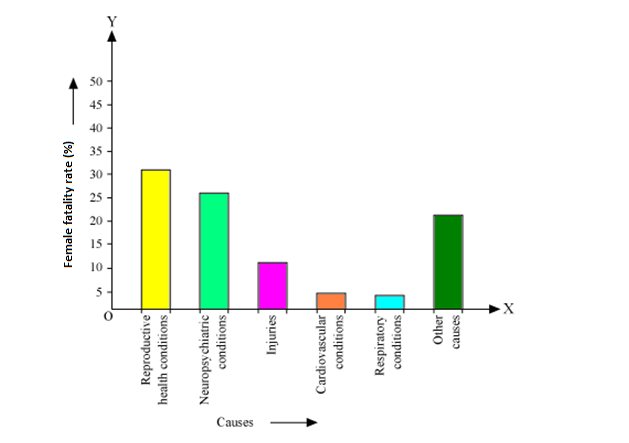
All the rectangle bars are of same width and having equal spacing between them.
(ii) Reproductive health condition is the major cause of women's ill health and death worldwide as 31.8% of women are affected by it.

All the rectangle bars are of same width and having equal spacing between them.
(ii) Reproductive health condition is the major cause of women's ill health and death worldwide as 31.8% of women are affected by it.
Question 2
The following data on the number of girls (to the nearest ten) per thousand boys in different sections of Indian society is given below.
Section
|
Number of girls per thousand boys
|
Scheduled Caste (SC)
Scheduled Tribe (ST)
Non SC/ST
Backward districts
Non-backward districts
Rural
Urban
|
940
970
920
950
920
930
910
|
(i). Represent the information above by a bar graph.
Solution 2
(i). By representing section (variable) on x axis and number of girls per thousand boys on y axis we can draw the graph of information given as above and choosing an appropriate scale (1 unit = 100 girls for y axis)
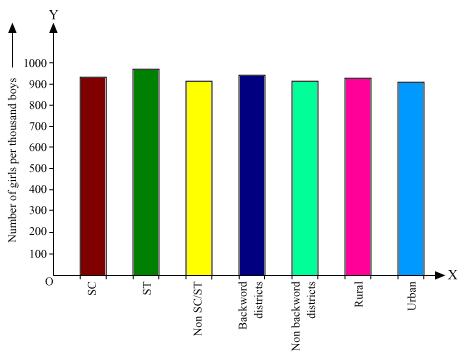
Here all the rectangle bars are of same width and have equal spacing in between them.

Here all the rectangle bars are of same width and have equal spacing in between them.
Question 3
Given below are the seats won by different political parties in the polling outcome of a state assembly elections:
Political Party
|
A
|
B
|
C
|
D
|
E
|
F
|
Seats Won
|
75
|
55
|
37
|
29
|
10
|
37
|
(i). Draw a bar graph to represent the polling results.
(ii). Which political party won the maximum number of seats?
Solution 3
(i). By taking polling results on x axis and seats won as y axis and choosing an appropriate scale (1 unit = 10 seats for y axis) we can draw the required graph of above information as below -

Here rectangle bars are of same width and have equal spacing in between them.
(ii). We may find that political party 'A' won maximum number of seats.

Here rectangle bars are of same width and have equal spacing in between them.
(ii). We may find that political party 'A' won maximum number of seats.
Question 4
The length of 40 leaves of a plant are measured correct to one millimeter, and the obtained data is represented in the following table:
Length (in mm)
|
Number of leaves
|
118 - 126
127 - 135
136 - 144
145 - 153
154 - 162
163 - 171
172 - 180
|
3
5
9
12
5
4
2
|
(i). Draw a histogram to represent the given data.
(ii). Is there any other suitable graphical representation for the same data?
(iii). Is it correct to conclude that the maximum number of leaves are 153 mm long? Why?
Solution 4
(i). Length of leaves are represented in a discontinuous class intervals having a difference of 1 in between them. So we have to add to each upper class limit and also have to subtract 0.5 from the lower class limits so as to make our class intervals continuous.
Length (in mm)
|
Number of leaves
|
117.5 - 126.5
|
3
|
126.5 - 135.5
|
5
|
135.5 - 144.5
|
9
|
144.5 - 153.5
|
12
|
153.5 - 162.5
|
5
|
162.5 - 171.5
|
4
|
171.5 - 180.5
|
2
|
Now taking length of leaves on x axis and number of leaves on y axis we can draw the histogram of this information as below -
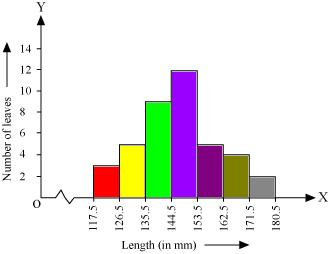
Here 1 unit on y axis represents 2 leaves.
(ii). Other suitable graphical representation of this data could be frequency polygon.
(iii). No as maximum number of leaves (i.e. 12) have their length in between of 144.5 mm and 153.5 mm. It is not necessary that all have their lengths as 153 mm.
Question 5
The following table gives the life times of neon lamps:
Length (in hours)
|
Number of lamps
|
300 - 400
400 - 500
500 - 600
600 - 700
700 - 800
800 - 900
900 - 1000
|
14
56
60
86
74
62
48
|
(i). Represent the given information with the help of a histogram.
(ii) How many lamps have a lifetime of more than 700 hours?
Solution 5
(i). By taking life time (in hours) of neon lamps on x axis and number of lamps on y axis we can draw the histogram of the given information as below - 
Here 1 unit on y axis represents 10 lamps.
(ii). Number of neon lamps having their lifetime more than 700 are sum of number of neon lamps having their lifetime as 700 - 800, 800 - 900, and 900 - 1000.
So number of neon lamps having their lifetime more than 700 hours is 184. (74 + 62 + 48 = 184)

Here 1 unit on y axis represents 10 lamps.
(ii). Number of neon lamps having their lifetime more than 700 are sum of number of neon lamps having their lifetime as 700 - 800, 800 - 900, and 900 - 1000.
So number of neon lamps having their lifetime more than 700 hours is 184. (74 + 62 + 48 = 184)
Question 6
The following table gives the distribution of students of two sections according to the marks obtained by them:
Section A
|
Section B
| ||
Marks
|
Frequency
|
Marks
|
Frequency
|
0 - 10
10 - 20
20 - 30
30 - 40
40 - 50
|
3
9
17
12
9
|
0 - 10
10 - 20
20 - 30
30 - 40
40 - 50
|
5
19
15
10
1
|
Represent the marks of the students of both the sections on the same graph by two frequency polygons. From the two polygons compare the performance of the two sections.
Solution 6
We can find class marks of given class intervals by using formula -
Class mark
Class mark
Section A
|
Section B
| ||||
Marks
|
Class marks
|
Frequency
|
Marks
|
Class marks
|
Frequency
|
0 - 10
|
5
|
3
|
0 - 10
|
5
|
5
|
10 - 20
|
15
|
9
|
10 - 20
|
15
|
19
|
20 - 30
|
25
|
17
|
20 - 30
|
25
|
15
|
30 - 40
|
35
|
12
|
30 - 40
|
35
|
10
|
40 - 50
|
45
|
9
|
40 - 50
|
45
|
1
|
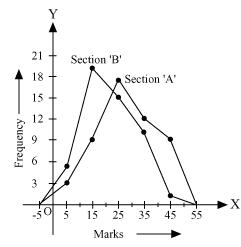
From the graph we can see performance of students of section 'A' is better than the students of section 'B' as for good marks.
Question 7
The runs scored by two teams A and B on the first 60 balls in a cricket match are given below:
Number of balls
|
Team A
|
Team B
|
1 - 6
7 - 12
13 - 18
19 - 24
25 - 30
31 - 36
37 - 42
43 - 48
49 - 54
55 - 60
|
2
1
8
9
4
5
6
10
6
2
|
5
6
2
10
5
6
3
4
8
10
|
Represent the data of both the teams on the same graph by frequency polygons.
Solution 7
We observe that given data is not having its class intervals continuous. There is a gap of 1 in between of them. So we have to add  = 0.5 to upper class limits and subtract 0.5 from lower class limits.
= 0.5 to upper class limits and subtract 0.5 from lower class limits.
Also class mark of each interval can be found by using formula - Class mark
Now continuous data with class mark of each class interval can be represented as following -
 = 0.5 to upper class limits and subtract 0.5 from lower class limits.
= 0.5 to upper class limits and subtract 0.5 from lower class limits. Also class mark of each interval can be found by using formula - Class mark
Now continuous data with class mark of each class interval can be represented as following -
Number of balls
|
Class mark
|
Team A
|
Team B
|
0.5 - 6.5
|
3.5
|
2
|
5
|
6.5 - 12.5
|
9.5
|
1
|
6
|
12.5 - 18.5
|
15.5
|
8
|
2
|
18.5 - 24.5
|
21.5
|
9
|
10
|
24.5 - 30.5
|
27.5
|
4
|
5
|
30.5 - 36.5
|
33.5
|
5
|
6
|
36.5 - 42.5
|
39.5
|
6
|
3
|
42.5 - 48.5
|
45.5
|
10
|
4
|
48.5 - 54.5
|
51.5
|
6
|
8
|
54.5 - 60.5
|
57.5
|
2
|
10
|
Now by taking class marks on x axis and runs scored on y axis we can construct frequency polygon as following -
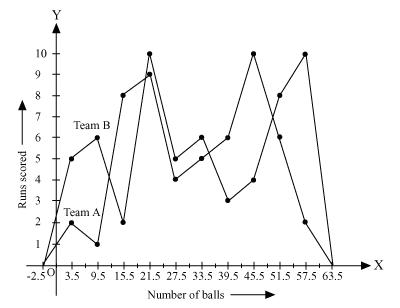
Question 8
A random survey of the number of children of various age groups playing in park was found as follows:
Age (in years)
|
Number of children
|
1 - 2
2 - 3
3 - 5
5 - 7
7 - 10
10 - 15
15 - 17
|
5
3
6
12
9
10
4
|
Solution 8
Here data is having class intervals of varying width. We may find proportion of children per 1 year interval as following -
Age (in years)
|
Frequency (Number of children)
|
Width of class
|
Length of rectangle
|
1 - 2
|
5
|
1
|  |
2 - 3
|
3
|
1
|  |
3 - 5
|
6
|
2
|  |
5 - 7
|
12
|
2
|  |
7 - 10
|
9
|
3
|  |
10 - 15
|
10
|
5
|  |
15 - 17
|
4
|
2
|  |
Now taking age of children on x axis and proportion of children per 1 year interval on y axis we may draw histogram as below -
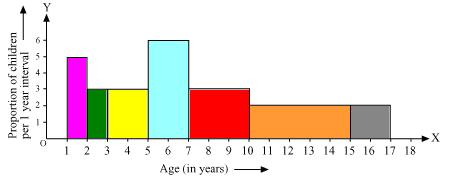
Question 9
100 surnames were randomly picked up from a local telephone directory and a frequency distribution of the number of letters in the English alphabet in the surnames was found as follows:
Number of letters
|
Number of surnames
|
1 - 4
4 - 6
6 - 8
8 - 12
12 - 20
|
6
30
44
16
4
|
(i). Draw a histogram to depict the given information.
(ii). Write the class interval in which the maximum number of surnames lie.
Solution 9
(i). Given data is having class intervals of varying width. We need to compute the adjusted frequency
Number of letters
|
Frequency (Number of surnames)
|
Width of class
|
Length of rectangle
|
1 - 4
|
6
|
3
|  |
4 - 6
|
30
|
2
|  |
6 - 8
|
44
|
2
|  |
8 -12
|
16
|
4
|  |
12 - 20
|
4
|
8
|  |
Now by taking number of letters on x axis and proportion of number of surnames per 2 letters interval on y axis and choosing an appropriate scale (1 unit = 4 students for y axis) we will construct the histogram as below
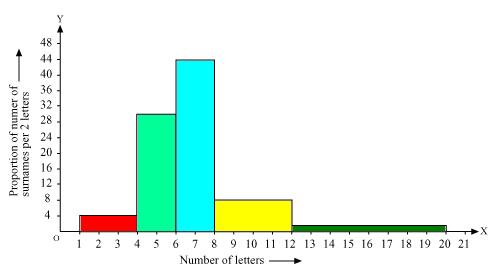
(ii). The class interval in which the maximum number of surname lie is
6 - 8 as there are 44 number of surnames in it i.e. maximum for this data.
NCERT Solution for Class 9 Mathematics Chapter 14 - Statistics Page/Excercise 14.4
Question 1
The following number of goals was scored by a team in a series of 10 matches:
2, 3, 4, 5, 0, 1, 3, 3, 4, 3
Find the mean, median and mode of these scores.
2, 3, 4, 5, 0, 1, 3, 3, 4, 3
Find the mean, median and mode of these scores.
Solution 1
The number of goals scored by team is
2, 3, 4, 5, 0, 1, 3, 3, 4, 3
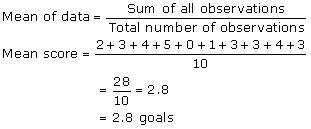 Arranging the number of goals in ascending order
Arranging the number of goals in ascending order
0, 1, 2, 3, 3, 3, 3, 4, 4, 5
As the number of observations is 10. 10 is an even number. So, median score will be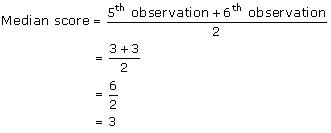
Mode of data is the observation with the maximum frequency in data.
So, mode score of data is 3 as it is having maximum frequency as 4 in the data.
2, 3, 4, 5, 0, 1, 3, 3, 4, 3
 Arranging the number of goals in ascending order
Arranging the number of goals in ascending order0, 1, 2, 3, 3, 3, 3, 4, 4, 5
As the number of observations is 10. 10 is an even number. So, median score will be

Mode of data is the observation with the maximum frequency in data.
So, mode score of data is 3 as it is having maximum frequency as 4 in the data.
Question 2
In a mathematics test given to 15 students, the following marks (out of 100) are recorded:
41, 39, 48, 52, 46, 62, 54, 40, 96, 52, 98, 40, 42, 52, 60
Find the mean, median and mode of this data.
41, 39, 48, 52, 46, 62, 54, 40, 96, 52, 98, 40, 42, 52, 60
Find the mean, median and mode of this data.
Solution 2
The marks of 15 students in mathematics test are
41, 39, 48, 52, 46, 62, 54, 40, 96, 52, 98, 40, 42, 52, 60
 Arranging the scores obtained by 15 students in an ascending order
Arranging the scores obtained by 15 students in an ascending order
39, 40, 40, 41, 42, 46, 48, 52, 52, 52, 54, 60, 62, 96, 98
As the number of observations is 15 that is odd so, median of data will be = 8th observation while data is arranged in an ascending or descending order
= 8th observation while data is arranged in an ascending or descending order
So, median score of data = 52
Mode of data is the observation with the maximum frequency in data. So mode of this data is 52 having the highest frequency in data as 3.
41, 39, 48, 52, 46, 62, 54, 40, 96, 52, 98, 40, 42, 52, 60
 Arranging the scores obtained by 15 students in an ascending order
Arranging the scores obtained by 15 students in an ascending order39, 40, 40, 41, 42, 46, 48, 52, 52, 52, 54, 60, 62, 96, 98
As the number of observations is 15 that is odd so, median of data will be
So, median score of data = 52
Mode of data is the observation with the maximum frequency in data. So mode of this data is 52 having the highest frequency in data as 3.
Question 3
The following observations have been arranged in ascending order. If the median of the data is 63, find the value of x.
29, 32, 48, 50, x, x + 2, 72, 78, 84, 95
29, 32, 48, 50, x, x + 2, 72, 78, 84, 95
Solution 3
Total number of observation in the given data is 10 (even number). So median of this data will be mean of  i.e. 5th and
i.e. 5th and  i.e. 6th observations
i.e. 6th observations 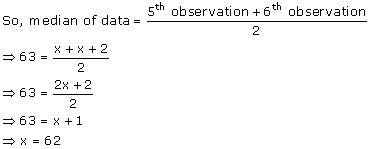

Question 4
Find the mode of 14, 25, 14, 28, 18, 17, 18, 14, 23, 22, 14, 18
Solution 4
Arranging the data in an ascending order
14, 14, 14, 14, 17, 18, 18, 18, 22, 23, 25, 28
Here observation 14 is having the highest frequency i.e. 4 in given data. So, mode of given data is 14.
14, 14, 14, 14, 17, 18, 18, 18, 22, 23, 25, 28
Here observation 14 is having the highest frequency i.e. 4 in given data. So, mode of given data is 14.
Question 5
Find the mean salary of 60 workers of a factory from the following table:
Salary (in Rs)
|
Number of workers
|
3000
|
16
|
4000
|
12
|
5000
|
10
|
6000
|
8
|
7000
|
6
|
8000
|
4
|
9000
|
3
|
1000
|
1
|
Total
|
60
|
Solution 5
As  Valaues of
Valaues of  and
and  can be computed
can be computed
 Valaues of
Valaues of
Salary (in Rs) (xi)
|
Number of workers (fi)
|
fixi
|
3000
|
16
|
3000 * 16 = 48000
|
4000
|
12
|
4000 * 12 = 48000
|
5000
|
10
|
5000 * 10 = 50000
|
6000
|
8
|
6000 * 8 = 48000
|
7000
|
6
|
7000 * 6 = 42000
|
8000
|
4
|
8000 * 4 = 32000
|
9000
|
3
|
9000 * 3 = 27000
|
10000
|
1
|
10000 * 1 = 10000
|
Total
|
 So, mean salary of 60 workers is Rs 5083.33.
So, mean salary of 60 workers is Rs 5083.33.
Question 6
Give one example of a situation in which
(i) The mean is an appropriate measure of central tendency.
(ii) The mean is not an appropriate measure of central tendency but the median is a appropriate measure of central tendency
(i) The mean is an appropriate measure of central tendency.
(ii) The mean is not an appropriate measure of central tendency but the median is a appropriate measure of central tendency
Solution 6
(i) Mean is appropriate measure of central tendency in all the cases where it is important to take all observations into account and data does not have any extreme values for example in case of temperature of a month
(ii) Mean is not suitable in cases where there are very high and low values for example salary in a company.
(ii) Mean is not suitable in cases where there are very high and low values for example salary in a company.
No comments:
Post a Comment